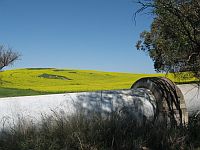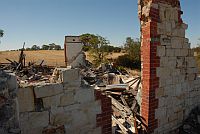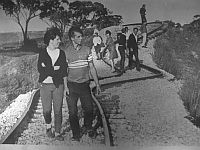History Of Meckering
The township of Meckering – like so many Western Australian towns – derives its name from an Aboriginal language and means ‘place of water’ or ‘moon on water’ depending upon the translation. It is apt that ‘water’ is present in the Meckering’s name as it was precisely this substance that led to its’ discovery and early settlement.

Originally known as Beebering, the name Meckering was chosen by explorer, John Forest with the official declaration of the townsite taking place on 17th February 1887.
Many decades earlier, in 1849, the first block of land – situated some 7kms south of Meckering near the rare and valuable well supplying good water - had been granted and was known as ‘Koolbunine’. Due to a lack of constant rainfall and surface water the area was not considered adequate for agricultural purposes until about 40 years later.
The first settlement was made in 1887 about 3kms north of Beebeering Hill but it was not until April 1889 that the surrounding land was declared an agricultural area.
The rail link to Kalgoorlie reached Meckering in 1892 and within six years the town was home to a railway station, three stores, a blacksmith, a hotel, a town hall, school, WA and Union banks and a post office. In addition, the office for local government administering the area as far east as Merredin was located in Meckering and remained there until 1920 when it was moved to Cunderdin.
Following the official declaration of the township in 1887 the school expanded and in 1898 the roll showed there were 60 children. Some pupils traveled by rail from as far as Doodlakine - 80 kms away.
The Goldfields Water Supply became available by 1901, supplying water to local residents. The 1903 a local cordial factory opened for business and continued to operate until 1950 supplying cool drinks across the entire state. From 1916 to 1958 power was supplied by a local plant, until the introduction of SEC power which further modernised the town.
From 1904 Meckering enjoyed the services of a local doctor and in 1920 a hospital was opened to cater for the surrounding areas. Both these services continued to operate until the closure of the hospital in 1939. Bulk handling of grain began in 1933 when an installation was built – a far cry from the modern structure evident today.
Meckering Earthquake - 40 Seconds That Changed A Town
Until the 14th October 1968, Meckering’s residents were experiencing typical small country town life. But at 10.59am the fate and the future of the town changed dramatically when in only 40 seconds WA’s most significant earthquake devastated the town. Registering 6.9 on the Richter Scale, the quake’s epicentre was almost directly below Meckering and caused a stretch of ground more than 40kms long to rupture. It was so strong that residents in Albany, Esperance and Perth reported damage.

For the town of Meckering the impact of the quake was devastating with more than 50 homes destroyed and shops, churches, buildings, sheds and water supplies ruined. Seventeen people were injured – some seriously – but amazingly no one was killed. Luckily it was a public holiday and the school and local shops were closed. Major roads fractured, telephone and power connections cut and the damage bill reached $1.5 million (somewhere in the vicinity of $5 million in today’s climate).
The Mundaring to Kalgoorlie Pipeline was severely damaged – a section of it has been preserved and can be viewed in Meckering at the Gazebo in Gabbedy Place. There is also an excellent display of photographs, statistics and information on the earthquake as well as a salvaged section of the damaged railway line. Even today there is still a one-kilometre stretch of the faultline visible – 12kms south of the town on the York to Meckering Road (click here for directions) and you may also like to visit the farm ruins at ‘Salisbury’ - an old stone wall homestead (built in 1904) wrecked in the quake.

Reconstruction of the town began soon after the quake but to the south west of the original site. Many fine new buildings were constructed including a Town Hall, Infant Health Clinic, shopping precinct, Inter-denominational Church, an air-conditioned Primary School and a Sporting Club.
The rebuilding of the town is a tribute to the community spirit of the residents and is physical evidence of the continuing pioneering attitude that originally enabled the area to be settled.